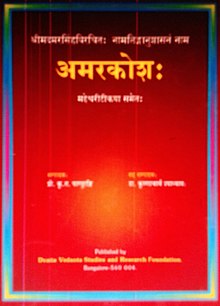This is an old revision of this page, as edited by Doug4 (talk | contribs) at 16:26, 4 July 2017 (I rearranged some information..). The present address (URL) is a permanent link to this revision, which may differ significantly from the current revision.
Revision as of 16:26, 4 July 2017 by Doug4 (talk | contribs) (I rearranged some information..)(diff) ← Previous revision | Latest revision (diff) | Newer revision → (diff)| This article needs additional citations for verification. Please help improve this article by adding citations to reliable sources. Unsourced material may be challenged and removed. Find sources: "Amarasimha" – news · newspapers · books · scholar · JSTOR (February 2017) (Learn how and when to remove this message) |

Amara Sinha (or Amara Simha, IAST: Amarasiṃha) (c. CE 375) was a Sanskrit grammarian and poet, of whose personal history hardly anything is known. He is said to have been "one of the nine gems that adorned the throne of Vikramaditya," and according to the evidence of Xuanzang, this is the Chandragupta Vikramaditya (Chandragupta II) who flourished about CE 375. Other sources describe him as flourishing in the 7th century. Most of Amarasiṃha's work was destroyed, with the exception of the celebrated Amara-Kosha (IAST: Amarakośa) (Treasury of Amara). The first reliable mention of the Amarakosha is in the Amoghavritti of Shakatayana composed during the reign of Amoghavarsha (814-867CE)
The Amarakosha is a vocabulary of Sanskrit roots, in three books, and hence sometimes called Trikanda or the "Tripartite". It is also known as "Namalinganushasana". The Amarakosha contains 10,000 words, and is arranged, like other works of its class, in metre, to aid the memory.
The first chapter of the Kosha was printed at Rome in Tamil character in 1798. An edition of the entire work, with English notes and an index by HT Colebrooke appeared at Serampore in 1808. The Sanskrit text was printed at Calcutta in 1831. A French translation by ALA Loiseleur-Deslongchamps was published at Paris in 1839. Louie Rice compiled the Kannada version of it and its available 4th edition was printed in 1927 which contains three khandas and 25 sargas.
References
- ^ "Amara-Simha" in Chambers's Encyclopædia. London: George Newnes, 1961, Vol. 1, p. 311.
- ^ Chisholm 1911.
- Amarakosha compiled by B.L.Rice, edited by N.Balasubramanya, 1970, page X
- Literary and Historical Studies in Indology, Vasudev Vishnu Mirashi, , Motilal Banarsidass Publ., 1975, p. 50-51
- Amarakoshaby Louie Rice edited by N.Balasubhramanyam
Attribution:
 This article incorporates text from a publication now in the public domain: Chisholm, Hugh, ed. (1911). "Amara Sinha". Encyclopædia Britannica. Vol. 1 (11th ed.). Cambridge University Press. p. 781.
This article incorporates text from a publication now in the public domain: Chisholm, Hugh, ed. (1911). "Amara Sinha". Encyclopædia Britannica. Vol. 1 (11th ed.). Cambridge University Press. p. 781.